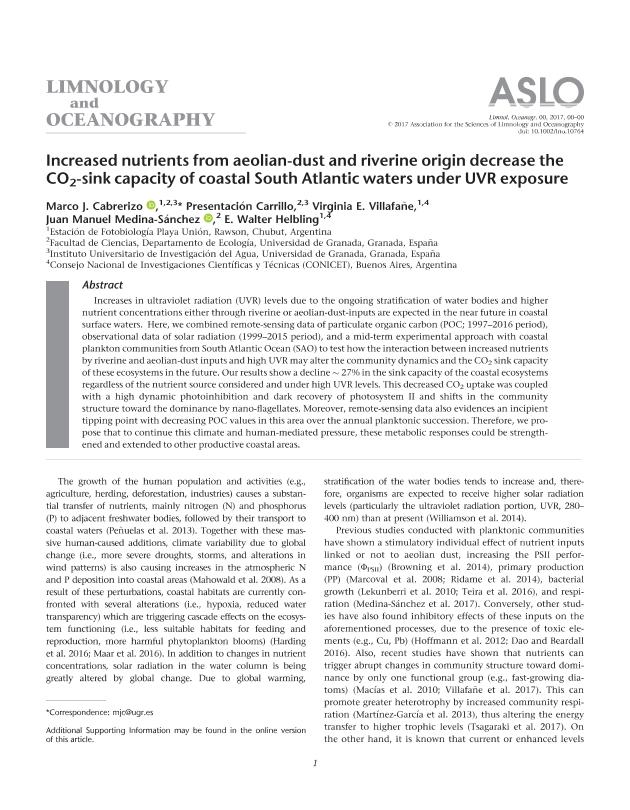Artículo
Increased nutrients from aeolian-dust and riverine origin decrease the CO2-sink capacity of coastal South Atlantic waters under UVR exposure
Cabrerizo, Marco J.; Carrillo, Presentación; Villafañe, Virginia Estela ; Medina Sánchez, Juan Manuel; Helbling, Eduardo Walter
; Medina Sánchez, Juan Manuel; Helbling, Eduardo Walter
 ; Medina Sánchez, Juan Manuel; Helbling, Eduardo Walter
; Medina Sánchez, Juan Manuel; Helbling, Eduardo Walter
Fecha de publicación:
05/2018
Editorial:
Wiley Blackwell Publishing, Inc
Revista:
Limnology and Oceanography
ISSN:
1939-5590
Idioma:
Inglés
Tipo de recurso:
Artículo publicado
Clasificación temática:
Resumen
Increases in ultraviolet radiation (UVR) levels due to the ongoing stratification of water bodies and higher nutrient concentrations either through riverine or aeolian-dust-inputs are expected in the near future in coastal surface waters. Here, we combined remote-sensing data of particulate organic carbon (POC; 1997–2016 period), observational data of solar radiation (1999–2015 period), and a mid-term experimental approach with coastal plankton communities from South Atlantic Ocean (SAO) to test how the interaction between increased nutrients by riverine and aeolian-dust inputs and high UVR may alter the community dynamics and the CO2 sink capacity of these ecosystems in the future. Our results show a decline ∼ 27% in the sink capacity of the coastal ecosystems regardless of the nutrient source considered and under high UVR levels. This decreased CO2 uptake was coupled with a high dynamic photoinhibition and dark recovery of photosystem II and shifts in the community structure toward the dominance by nano-flagellates. Moreover, remote-sensing data also evidences an incipient tipping point with decreasing POC values in this area over the annual planktonic succession. Therefore, we propose that to continue this climate and human-mediated pressure, these metabolic responses could be strengthened and extended to other productive coastal areas.
Palabras clave:
CO2
,
UVR
,
PHYTOPLANKTON
Archivos asociados
Licencia
Identificadores
Colecciones
Articulos(SEDE CENTRAL)
Articulos de SEDE CENTRAL
Articulos de SEDE CENTRAL
Citación
Cabrerizo, Marco J.; Carrillo, Presentación; Villafañe, Virginia Estela; Medina Sánchez, Juan Manuel; Helbling, Eduardo Walter; Increased nutrients from aeolian-dust and riverine origin decrease the CO2-sink capacity of coastal South Atlantic waters under UVR exposure; Wiley Blackwell Publishing, Inc; Limnology and Oceanography; 63; 3; 5-2018; 1191-1203
Compartir
Altmétricas



